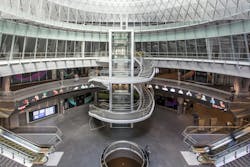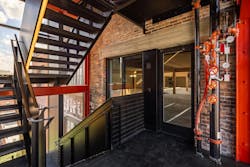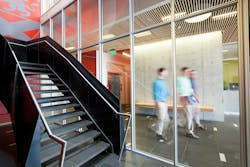Fire-Rated Frames Contribute More Than Code Compliance
Defending against fire is an essential part of safer school design. It is also a code requirement in many commercial occupancies—from retail and multifamily buildings to offices and warehouses—and for good reason. Consider warehouse fires. They are responsible for nearly 155 million dollars of lost assets each year, which is significant when considering they account for less than one percent of total commercial property fires. Further, the National Fire Protection Association (NFPA) estimates that structure fires in industrial and manufacturing properties account for the largest share of civilian injuries on these types of properties.
Designing with fire and life safety in mind is not just a code requirement but also vital to protecting people and businesses. Previously, fire-rated designs may have limited building professionals to opaque materials, but advances in fire-rated glass and framing materials and fabrication techniques have allowed more design freedom. This includes designing code-compliant buildings that optimize access to daylight, maximize visual connection and maintain aesthetic cohesion throughout spaces. As such, fire-rated glass makes it possible to improve building safety and improve occupant well-being.
Creating a cohesive design with slender, fire-rated frames
Due to past material limitations, fire-rated glazing was limited to 100 square inches within a fire door and less than 25 percent of a wall’s total area. However, fire-rated glass and framing can now achieve both fire-protective and fire-resistive ratings in intervals between 20 and 120 minutes with the required hose stream test. With these ratings, fire-rated glazing assemblies can be used in a variety of applications—from windows and doors along exit corridors to full wall and floor assemblies.
While glass ceramic and intumescent materials have allowed fire-rated glazing in more areas of the built environment, traditional fire-rated framing fabrication methods resulted in framing profiles that were often bulkier than their non-rated counterparts, which disrupted visual cohesion. To solve this issue, industry-leading manufacturers turned to cold, rollforming techniques first pioneered in Europe. Utilizing these advanced methods, they could fabricate fire-rated frames with narrow profiles that offer a close visual match to non-rated framing systems.
Narrow-profile steel frames also provide the strength necessary to both hold the additional weight of fire-rated glazing and increase possible free span size. This type of frame allows both exterior and interior curtain walls to maximize glazing areas and create a sense of visual cohesion throughout the built environment. Likewise, these narrow profile, fire-rated frames can support stairwell design beyond meeting fire and life safety codes. Stairwells can incorporate both fire-rated and non-fire-rated glazing in close proximity. When elements like fire-rated windows, doors and sidelites can blend seamlessly with other non-rated assemblies, it can elevate the entire design by minimizing visual distractions.
Narrow-profile, fire-rated frames can also be used as perimeter framing for butt-glazed assemblies. These transparent fire-rated walls replace vertical mullions with nearly colorless transitions between lites of glass. As a result, they allow designers to compartmentalize large spaces without having to sacrifice visual connectivity.
These fire-rated solutions expand the number of possible code-compliant designs. As a result, building professionals have more options when creating spaces that need to defend against fire and other life safety threats.
Adding unique flair to fire-rated designs with custom cover caps and framing finishes
Beyond maximizing the glazing surface, narrow profile, fire-rated frames can also incorporate custom cover caps to broaden the aesthetic possibilities.
For example, designers can choose different cover cap shapes to subtly change the look of a glazing system—from the crisp lines of a box cap to the more minimal look of an angle cap. Conversely, designers can adjust the material, such as opting for cover caps wrapped in real wood veneers to create fire-rated glazing assemblies with a rustic warmth. This option can support retrofit projects in historic buildings by allowing designers to meet current fire- and life-safety building code requirements without having to significantly alter a site’s interior. In addition to cover caps, fire-rated frames can also be finished in a wide range of colors—from brushed stainless steel to dramatic black frames.
Because narrow-profile, fire-rated frames can maintain visual consistency, even within designs that require unique finishes, they can be indispensable for achieving contemporary and code-compliant designs. Building professionals can use fire-rated glazing systems to promote visual connection and optimize access to daylight, both of which can help a design center code-compliant occupant well-being in bold and subtle ways.



